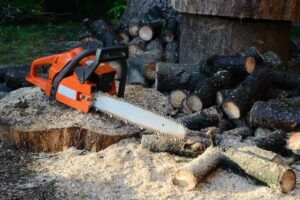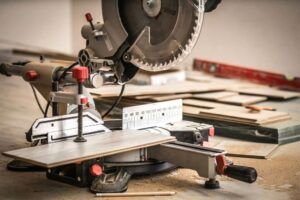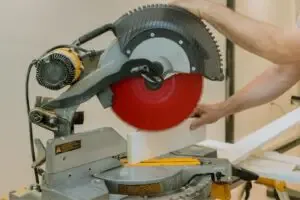
Miter saws are ideal power tools for making cross cuts or angled cuts. They come in a variety of sizes, with the most common sizes being 10-inch and 12-inch sizes.
You might wonder if the size of a miter saw really matters. As a matter of fact, size plays a big role when it comes to performance.
In this article, we’re going to compare between 10 inch vs 12 inch miter saw performance capabilities.
At the end, you will be able to make a rational decision that will see you end up with the best size for the job.
Table of Contents
10 Inch Miter Saw
The 10-inch blades have a few advantages over their larger counterparts. First, they are less expensive and are readily available. You can easily get them from power tools store at very affordable prices.
Also, they are lighter and smaller than their 12-inch versions. You can easily transport them to worksite at your own convenience. They come in a wider variety, giving you more than enough options to choose from.
Their lightweight and small size mean they spin faster when the motor power remains constant. They make finer and smoother cuts due to their higher RPMs.
Due to their small blades, 10 inch miter saws generate fewer wobble, which guarantees smoother cuts. They can cut up to 6 inches thick trim and molding boards. And because of their finer cuts, you can snugly joint trim boards together with ease.
- Smaller and highly portable.
- Smoother cutting
- Cheaper to purchase and sharpen.
- More energy-efficient.
- Can not cut thicker materials.
- Have insufficient table area.
12 Inch Miter Saw
The 12-inch blades also have some remarkable advantages over their smaller 10-inch versions. First off, they cut wider and thicker boards, making them best for heavy-duty wood cutting operations. Their electric motors are usually powerful and use only 15 Amp of electricity.
Besides impressive heavy-duty performance, 12 inch miter saw units offer performance versatility. You can use a 10-inch miter blade with your 12-inch miter saw.
Using a smaller blade on your 12-inch miter saw boosts RPM which improves cutting performance. Durability is another advantage that these units have over their smaller versions.
Their bodies are more rugged and larger. These specifications guarantee unmatched durability for prolonged performance.
- Better cutting capacity
- More durable
- Can use for large projects
- More expensive
- Larger and heavier
What Are Different 10 Inch vs 12 Inch Miter Saw?
The features or specification of a miter saw unit determines its performance. For you to decide which miter saw size is best for you, let’s dive deep into comparing their features and specifications.

Weight
10-inch miter saws are smaller in size than 12-inch units. On the other hand, 12-inch miter saw units have larger and more rugged bodies. Their large size adds more weight to their overall design.
10-inch miter saws weigh around 25 pounds while their 12-inch counterparts can weigh up to 56 pounds. In case you are looking for portability in a miter saw unit, you should consider the lighter 10-inch miter saw units. They are easier to transport to worksite as compared to 12-inch versions.
Spinning Speed
For a given motor power, 10-inch miter saw blades spin a lot faster than 12-inch blades. For example, a 3 horsepower motor will spin a 10-inch blade faster than a 12-inch one. Due to this reason, 10-inch blades produce finer and smoother cuts during angled cut operations.
When 10-inch miter saw have up to 5,000 RPM, 12-inch units have up to 3,800 RPMs. If you’re looking to make smoother and finer cut finishes, 10-inch miter saws are your best chance.
Cutting Performance
10-inch blades are definitely smaller than 12-inch blades. They can cut materials of up to 6 inches thick. They are best for lightweight woodcutting projects such as sizing up some 4×4 or cutting some trim and molding boards.
But if you want to cut much thicker materials, a 12-inch miter saw will come in handy. Besides, their motors are usually more powerful, making them best for heavy-duty woodcutting performance.
Availability On The Market
10-inch miter saws come in a wider variety of models. They give you more options to choose from. Plus, their blades are not only cheaper to purchase or sharpen but are readily available as well.
On the other hand, you will have a harder time looking for a blade for your 12-inch miter saw due to their limited availability. Also, you might spend a few extra bucks sharpening their blades if they become dull.
Durability
12-inch miter saws have more rugged bodies than their smaller version. As such, they’re more durable. They also perform heavy-duty woodwork operations better and for longer.
If you’re looking for a highly durable miter saw units for your professional woodworks, then you have 12-inch miter saw units to take full advantage of.
Usage Versatility
If you have a 12-inch miter saw, you can actually fit a 10-inch blade for use, as long as the arbor fits through. As such, 12-inch miter saws bring versatility in usage as far as blade usage goes.
You can only wish the same statement were true with 10-inch miter saws. You cannot fit a 12-inch blade to a 10-inch miter saw for performance.
Table of Saws
10-inch miter saws have smaller tables because they are designed for light-duty performance. On the other hand, 12-inch miter saws have larger table areas to handle larger workpieces. Depending on your workpiece you can either choose a 10-inch or 12-inch miter saw unit for your DIY woodwork projects.
Miter Saw Adjustability
If you’re looking to adjust the miter saw blade for bevel cuts, you will need to decide on which unit you should end up with. 10-inch miter saw units adjust from zero to 52 degrees to the right and zero to 45 degrees to the left. This adjustability comes in handy to assist you make bevel cuts.
12-inch miter saws adjust further. For example, they adjust from zero to 60 degrees to the right and zero to 50 degrees to the left. As such, they make more angled cuts than their 10-inch brothers. If you’re looking for more angled cuts, then you know 12-inch miter saws have you covered.
The Cost
12-inch miter saws seem more expensive 10-inch version. But they are worth every single buck especially if you’re looking for heavy-duty performance from your miter saw unit.
However, they are also quite expensive to replace in case they break down beyond repair. Their blades are also more expensive to replace or sharpen.
The 10-inch miter saws, on the other hand, are more affordable. If you’re looking for affordability and light-duty performance, 10-inch miter saw units are the best choice you have at hand.
Conclusion
Before you can make any decision, you will have to consider a few factors. You should choose a 12-inch miter saw if you prefer getting more angled cuts. They are very ideal for producing cuts that are angled according to your preferences.
The 12-inch is also ideal for larger projects. If you are one of those people who fit the descriptions above then consider acquiring the 12-inch miter saws.
However, if you prefer a more portable unit to handle simple tasks, and smoother cuts you should choose 10-inch miter saws. These saws are also great in handling most DIY projects in your workshops.
If you have any DIY project in your mind then 10-inch miter saw will be your most suited option. In the event that you need a basic miter saw as well, you might consider using these blades.
Once you have assessed your performance goal, you can settle on a suitable unit. It always depends on the nature of the cut you want a unit to give you.








![9 Best Pole Saws of 2023 [Ultimate Guide] 9 Best Pole Saws of 2023 [Ultimate Guide]](https://handykeen.b-cdn.net/wp-content/uploads/2021/03/best-pole-saw-300x200.jpg)



